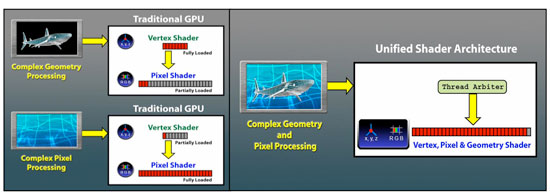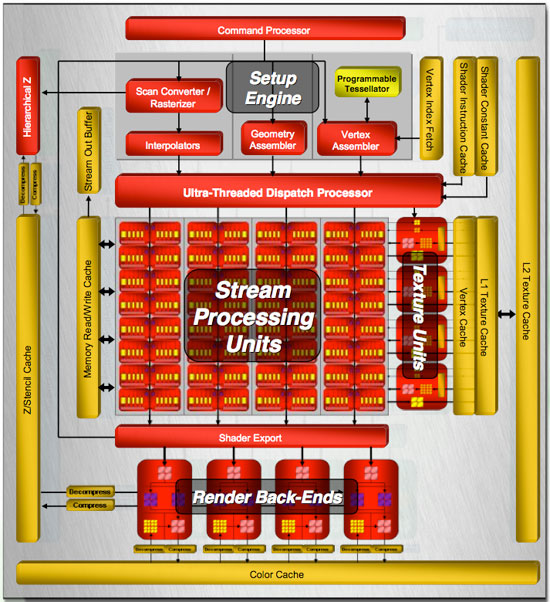ATI Radeon HD 2900 XT: Calling a Spade a Spade
by Derek Wilson on May 14, 2007 12:04 PM EST- Posted in
- GPUs
R600 Overview
From a very high level, we have the same capabilities we saw in the G80, where each step in the pipeline runs on the same hardware. There are a lot of similarities when stepping way back, as the same goals need to be accomplished: data comes into the GPU, gets setup for processing, shader code runs on the data, and the result either heads back up for another pass through the shaders or moves on to be rendered out to the framebuffer.

The obvious points are that R600 is a unified architecture that supports DX10. The set of requirements for DX10 are very firm this time around, so we won't see any variations in feature support on a basic level. AMD and NVIDIA are free to go beyond the DX10 spec, but these features might not be exposed through the Microsoft API without a little tweaking. AMD includes one such feature, a tessellator unit, which we'll talk about more later. For now, let's take a look at the overall layout of R600.

Our first look shows a huge amount of stream processing power: 320 SPs all told. These are a little different than NVIDIA's SPs, and over the next few pages we'll talk about why. Rather than a small number of SPs spread across eight groups, our block diagram shows R600 has a high number of SPs in each of four groups. Each of these four groups is connected to its own texture unit, while they share a connection to shader export hardware and a local read/write cache.
All of this is built on an 80nm TSMC process and uses in the neighborhood of 720 Million transistors. All other R6xx parts will be built on a 65nm processes with many fewer transistors, making them much smaller and more power efficient. Core clock speed is on the order of 740MHz for R600 with memory running at 825MHz.
Memory is slower this time around with higher bandwidth, as R600 implements a 512-bit memory bus. While we're speaking about memory, AMD has revised their Ring Bus architecture for this round, which we'll delve into later. Unfortunately we won't be able to really compare it to NVIDIA's implementation, as they won't go into any detail with us on internal memory buses.
And speaking of things NVIDIA won't go into detail on, AMD was good enough to share very low level details, including information on cache sizes and shader hardware implementation. We will be very happy to spend time talking about this, and hopefully AMD will inspire NVIDIA to start opening up a little more and going deeper into their underlying architecture.
To hit the other hot points, R600 does have some rather interesting unique features to back it up. Aside from including a tessellation unit, they have also included an audio processor on their hardware. This will accept audio streams and send them out over their DVI port through a special converter to integrate audio with a video stream over HDMI. This is unique, as current HDMI converters only work with video. AMD also included a programmable AA resolve feature that allows their driver team to create new ways of filtering subsample data.
R600 also features an independent DMA engine that can handle moving and managing all memory to and from the GPU, whether it's over the PCIe bus or local memory channels. This combined with huge amounts of memory bandwidth should really assist applications that require large amounts of data. With DX10 supporting up to 8k x 8k textures, we are very interested in seeing these limits pushed in future games.
That's enough of a general description to whet your appetite: let's dig down under the surface and find out what makes this thing tick.










86 Comments
View All Comments
GoatMonkey - Monday, May 14, 2007 - link
That's obviously BS. This IS their high end part, it just doesn't perform as well as nVidia's high end part, so it is priced accordingly.poohbear - Monday, May 14, 2007 - link
sweet review though! thanks for including all the important and pertinent cards in your roundup (the 8800gts 320mb inparticular). also love how neutral Anand is in their reviews, unlike some other sites.:pCreig - Monday, May 14, 2007 - link
The R600 is finally here. I'm sure the overall performance is not what AMD was hoping for. Nobody ever shoots to have their newest product be the 2nd best. But pricing it at $399 and including a very nice game bundle will make the HD 2900 XT a VERY worthwhile purchase. I also have the feeling that there is a significant amount of performance increase to be realized through future driver releases ala X1800XT.shady28 - Tuesday, May 15, 2007 - link
Nvidia has gone over the cliff on pricing.
I know of no one personally who has an 88xx series card. I know one who recently picked up an 8600 of some kind, that's it. I have the best GPU of anyone I know.
It's a real shame that there is so much focus on graphics cards that virtually no one buys. These are niche products folks - yet 'who is best' seems to be totally dependent on these niche products. That's patently ridiculous.
It's like saying, since IBM makes the fastest computers in the world (they do), they're the best and you should be buying IBM (or now, lenovo) laptops and desktops.
No one ever said that sort of thing because it's patently ridiculous. Why do people say it now for graphics cards? The fact that they do says a lot about the mentality of sites like AT.
DerekWilson - Tuesday, May 15, 2007 - link
We don't say what you are implying, and we are also very upset with some of NVIDIA's pricing (specifically the 8800 ultra)the 8800 gts 320mb is one of the best values for your money anywhere and isn't crazy expensive -- it's actually the card I'd recommend to anyone who cares about graphics in games and wants good quality and performance at 1600x1200.
I would never tell anyone to buy an 8600 gts because nvidia has the fastest high end card. In fact, in this article, I hope I made it clear that AMD has the opportunity to capitalize on the huge performance gap nvidia left between the 8600 and 8800 series ... If AMD builds a part that performs in this range is priced competitively, they'll have our recommendation in a flash.
Recommending parts based on value at each price or performance segment is something we take pride in and will always do, no matter who has the absolute fastest hardware out there.
The reason our focus was on AMD's fastest part is because they haven't given us any other hardware to test. We will absolutely be talking a lot and in much depth about midrange and budget hardware when AMD makes these parts available to us.
yacoub - Monday, May 14, 2007 - link
$400 is a lot of money. Not terribly long ago the highest end GPU available didn't cost more than $400. Now they hit $750 so you start to think $400 sounds cheap. It's really not. It's a heck of a lot of money for one piece of hardware. You can put together a 650i SLI rig with 2GB of DDR2 6400 and an E4400 for that much money. I know because I just did that. I kept my 7900GT from my old rig because I wanted to see how R600 did before purchasing an 8800GTS 640MB. Now that we've seen initial results I will wait to see how R600 does with more mature drivers and also wait to see the 640MB GTS price come down even more in the meantime.vijay333 - Monday, May 14, 2007 - link
http://www.randomhouse.com/wotd/index.pperl?date=1...">http://www.randomhouse.com/wotd/index.pperl?date=1..."the expression to call a spade a spade is thousands of years old and etymologically has nothing whatsoever to do with any racial sentiment."
yacoub - Monday, May 14, 2007 - link
Yes, a spade was a shovel long before muslims enslaved europeans to do hard labor in north africa and europeans enslaved africans to do hard labor in the 'new world'.vijay333 - Monday, May 14, 2007 - link
whoops...replied to the wrong one.rADo2 - Monday, May 14, 2007 - link
It is not 2nd best (after 8800ULTRA), not 3rd best (after 8800GTX), not 4th best (after 8800GTX-640), but 5th best (after 8800GTS-320), or even worse ;)Bad performance with AA turned on (everybody turns on AA), huge power consumption, late to the market.
A definitive failure.